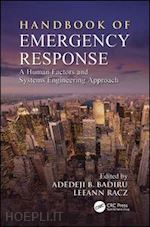Technical ChallengesRobotic Technologies for First Response: A Review, Julie A. AdamsA Practical, Simplified Chemical Agent Sensor Placement Methodology, David A. Smith and David R. JacquesHarnessing Disruptive Technologies: Quick Systems Engineering for Emergency Response, Brian J. PhillipsAn Emerging Framework for Unmanned Aircraft Systems in the National Airspace System: Opportunities and Challenges for First Responders and Emergency Management, Robin R. SobottaOptimization in Evacuation Route Planning, Gino J. Lim and Mukesh RungtaEvacuation Planning, Analysis, and Management, Michael K. LindellHierarchical Optimization for Helicopter Mission Planning in Large-Scale Emergencies, Linet Özdamar, Onur Demir, Erdinc Bakir, and Samet Yilmaz Planning and Management of Transportation Systems for Evacuation, P. Brian Wolshon and Vinayak DixitRiverflow Prediction for Emergency Response: Military Applications Using Artificial Neural Networks, Bernard B. Hsieh and Mark R. JourdanHuman Factors IssuesUnderstanding the Influence of the "Cry Wolf Hypothesis" and "False Alarm Effect" on Public Response to Emergency Warnings, Ann Marie Major and L. Erwin AtwoodAccessible Emergency Management: A Human Factors Engineering Approach, Tonya L. Smith-Jackson, Woodrow W. Winchester, Ali Haskins Lisle, William H. Holbach, Hal Brackett, and Tom MartinFramework for Preparing for the Unprepared, Kera Z. Watkins, Anuradha Venkateswaran, and Katrina Simon-AgoloryLest we forget: A Critical Analysis of Bioterrorist Incidents, National Exercises and U.S. Prevention, Response, and Recovery Strategies, Tasha L. PravecekResilience to WMD: Communication and Active Participation are Key, Michelle L. SpencerFirst responders: A Biomechanical Evaluation of Supply Distribution, Susan Gaines, Arturo Watlington, III, and Pamela M. BushDynamics and Dangers of Therapeutic Strategies for Organophosphate Poisoning: A Physiologically Based Model, Gregory G. Seaman, Michael L. Shelley, Jeffrey M. Gearhart and David A. SmithManagerial ModelsCoordinated Project Systems Approach to Emergency Response, Adedeji B. BadiruOvercoming Obstacles to Integrated Response among Incongruent Organizations, Robert K. CampbellDecisions in Disaster Recovery Operations: A Game Theoretic Perspective on Organization Cooperation, John B. Coles and Jun ZhuangIntegrating Department of Defense Response with Nongovernmental Options during a Disaster, Harley M. Connors, Helen W. Phipps, and Michael J. Surette Jr.Time is a Murderer: The Cost of Critical Path Drag in Emergency Response, Stephen A. DevauxCoordination and Control in Emergency Response, John M. Flach, Debra Steele-Johnson, Valerie L. Shalin, and Glenn C. HamiltonManaging the Complexities of Incident Command, James R. GruenbergBegin with the End in Mind: "An All-Hazards Systems Approach to Waste Management Planning for Homeland Security Incidents", Mario E. IerardiCreating Effective Response Communications, Tay W. JohannesAssessing the State of Knowledge about Emergency Management in Other Countries, David A. McEntireFramework for Real-Time, All-Hazards Global Situational Awareness, Olufemi A. Omitaomu, Steven J. Fernandez, and Budhendra L. BhaduriAll-Hazards Response Team Preparation: Planning and Training Concepts, Paul S. Pirkle IIIMedical Supply Chain Resiliency in Disasters, Jack E. Smith IIDecision Support for Inland Waterways Emergency Response, Heather Nachtmann, Edward A. Pohl, and Leily FarrokhvarIndex











